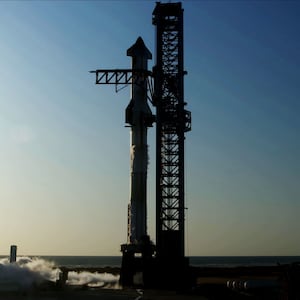Japanese aerospace company ispace attempted to make history on Tuesday when it sought to land a robotic probe on the surface of the moon—which would have made it both the first private company to ever do so and the first time a Japanese mission has ever achieved a lunar landing.
Unfortunately, it did not go as planned. Shortly after the expected landing, ispace mission control could not immediately establish communication with the lander—and, therefore, they were not able to confirm a safe landing on the lunar surface. It's now widely believed the lander crashed on its way to the ground.
“We already confirmed that we established communication at the very end of the landing,” Takeshi Hakamada, founder and CEO of ispace, glumly told a crowd gathered to watch the event. “However, we’ve now lost communication so we have to assume that we could not complete the landing on the lunar surface.”
ADVERTISEMENT
Hakamada did offer a small silver lining: the team was able to gather valuable flight data during the landing phase of Hakuto-R M1. This data and those gathered in the coming days will prove to be invaluable as they plan future attempts to land on the lunar surface. “That is a great achievement for future missions,” he added.
ispace launched the Hakuto-R Mission 1 (M1) lander on December 11, 2022 aboard a SpaceX Falcon 9 rocket. In March, the spacecraft entered lunar orbit where it circled the moon as it readied for touchdown. On Tuesday, it was sent on its way to the moon’s Atlas crater, along with a slew of scientific and technological payloads to the surface. The company had hoped to prove that its lander could be a low-cost and effective way for private and public entities to send different kinds of payloads to the moon.
Hakuto-R M1’s payloads included a 22-pound lunar rover called Rashid engineered by the United Arab Emirates (marking the first time an Arab country has attempted a lunar mission); a ball-like robot called SORA-Q created by the Japanese Aerospace Exploration Agency and Takara Tomy (the toy company behind Transformers), and an experiment to test a new kind of solid-state battery.
The unfortunate outcome of the mission highlights the notorious difficulty of landing on the moon by private companies and smaller entities, and how big agencies like NASA and the Chinese space agency are really the exception. Other recent efforts have also failed spectacularly. In September 2019, India attempted to put its own lunar lander on the moon, which crash landed after malfunctioning. In April 2019, the Beresheet lunar lander from Israeli companies SpaceIL and Israel Aerospace Industries attempted to land on the moon—and ended up crashing after a catastrophic gyroscope failure caused its engines to shut off during the attempt.
Part of the reason has to do with the fact that it’s not easy finding a good place to land on the moon due to its craterous and rocky surface. Not only that, but as with Hakuto-R M1, these landings have to be done autonomously. Mission control’s role is to simply observe the preprogrammed landing from Earth. Humans can’t intervene midway to make changes, because it is incredibly difficult to establish reliable communication signals due to the moon’s orbit and rotation.
The loss of the mission is also a loss for the UAE and ispace’s other partners. Rashid, which was roughly the size of a dining room chair, was sent to explore the lunar surface using two high-resolution cameras, a microscopic camera, and thermal imaging camera. It was also equipped with a probe that’s capable of sampling the plasma above the moon’s surface. SORA-Q was meant to test out its ball-shaped design presumably to see if BB-8 from the Star Wars movies could actually move around like that.






